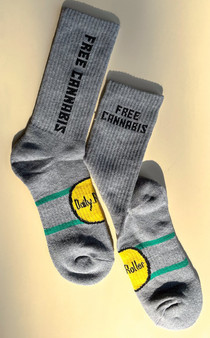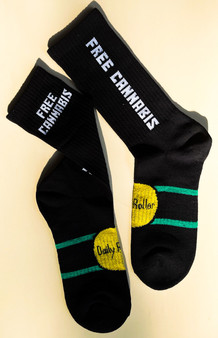Product Description
Step into a world of cannabis-inspired fashion with these Free Cannabis socks from Daily Roller.
Stacked and Horizontal 'FREE CANNABIS' print on each pair for versatile/ unique wearing opportunities!
CRIMINAL INJUSTICES • LEGISLATIVE ABUSE • SOCIAL STIGMATIZATION
Inspired by culture, and experiences of cannabis entrepreneurs.
According to the ACLU, from 2010 to 2018 more than six million people were arrested for marijuana related charges. On average United States law enforcements spend, collectively, $3.6B+ enforcing possession laws. This happening all while the government allows corporations/ special interests ability to patent cannabis derivatives for medical purposes.
Since the turn of 20th Century, cannabis has become controversial, falling from its grace as a "fashionable" consumable to become propagandized as a "dangerous or poison drug".
The heat has been on cannabis especially since the 1930s with the formation of the Federal Bureau of Narcotics, and the 1936 Convention for the Suppression of the Illicit Traffic in Dangerous Drugs.
We belive that the money and resources used for the War on Cannabis can be better utilized and reallocated to strengthening our communities health & fitness, arts, and/or education. Given US PATENT No. 6,630,507, the argument against cannabis having no medicinal use looks to be disproven -calling for a complete schedule reclassification! The current state of affairs is currently costing entrepreneurs millions in 280E taxes, unsafe cash storage practices, and missed business growth opportunities from having financials accounts shutdown unexpectedly due to legal gray area.
In summary, Free Cannabis by Daily Roller is peaceful & tactfully voicing disapproval, unifiying stakeholders for strength in numbers, and offering a platform to discuss the judicial- political state of our society.
Join Daily Roller Unite for Justiciable Access to Cannabis, today!
Celebrate your individuality and embrace the cannabis-inspired lifestyle with Daily Roller. Our Free Cannabis socks are the perfect addition to your wardrobe, offering both comfort and bold style. With their conversation starting design and high-quality materials, these socks are a must-have for any cannabis enthusiast looking to express themselves in a fashionable way.
Comfort and Quality, Wrapped in Style
Our Free Cannabis socks are carefully crafted using premium materials to ensure maximum comfort and durability. The 100% white cotton option provides a soft and breathable feel, while the nylon grey option offers absoprtion and comfort during challenging physical activities. No matter your preference, both options deliver unparalleled comfort and quality.
Make a Statement with Free Cannabis Graphics
Our Free Cannabis socks feature a bold and captivating text graphic that proudly displays your love for cannabis. The words 'Free Cannabis' are prominently displayed on each sock, allowing you to showcase your passion and ignite conversations wherever you go. Express yourself with confidence and style, making a statement that reflects your unique personality.
Versatile Options for Every Style
Whether you prefer a classic and clean look or a more contemporary and edgy style, our Free Cannabis socks have you covered. The 100% white cotton option offers a timeless and versatile choice that pairs well with any outfit, while the nylon grey option adds an athletic twist with its performance materials. Mix and match, or choose your favorite style to complement your unique fashion sense.
Unbeatable Value with Bundle Offers
We want to ensure that you can enjoy our Free Cannabis socks to the fullest. That's why we offer unbeatable value with our bundle offers. Purchase one pair for $20, or take advantage of our special deals and buy two pairs for $30 or five pairs for $50. Treat yourself or share the cannabis-inspired style with your friends and loved ones. It's a win-win for everyone!
Join the Daily Roller Community
Become part of a vibrant and diverse inclusive community that embraces the dynamic and active cannabis lifestyle. We encourage personal liberty, independence, and social economic progress. By wearing our Free Cannabis socks, you join a movement that celebrates individuality and empowers you to express yourself authentically.
Step into a world of cannabis-inspired style and comfort with Daily Roller's Free Cannabis socks. Experience the perfect blend of cannabis-inspired fashion, comfort, and quality. Express yourself boldly with our conversation starting text based graphics, and enjoy the unbeatable value of our bundle offers. Embrace your unique style and become part of our thriving community.
War On Cannabis Timeline(soruce: PBS FRONTLINE)
|
1600-1890s
|
Domestic production of hemp encouraged American production of hemp was encouraged by the government in the 17th century for the production of rope, sails, and clothing. (Marijuana is the mixture of dried, shredded flowers and leaves that comes from the hemp plant.) In 1619 the Virginia Assembly passed legislation requiring every farmer to grow hemp. Hemp was allowed to be exchanged as legal tender in Pennsylvania, Virginia, and Maryland. Domestic production flourished until after the Civil War, when imports and other domestic materials replaced hemp for many purposes. In the late nineteenth century, marijuana became a popular ingredient in many medicinal products and was sold openly in public pharmacies. During the 19th century, hashish use became a fad in France and also, to some extent, in the U.S.
|
|
1906
|
Pure Food and Drug Act Required labeling of any cannabis contained in over-the-counter remedies.
|
|
1900 - 20s
|
Mexican immigrants introduce recreational use of marijuana leaf After the Mexican Revolution of 1910, Mexican immigrants flooded into the U.S., introducing to American culture the recreational use of marijuana. The drug became associated with the immigrants, and the fear and prejudice about the Spanish-speaking newcomers became associated with marijuana. Anti-drug campaigners warned against the encroaching "Marijuana Menace," and terrible crimes were attributed to marijuana and the Mexicans who used it.
|
|
1930s
|
Fear of marijuana During the Great Depression, massive unemployment increased public resentment and fear of Mexican immigrants, escalating public and governmental concern about the problem of marijuana. This instigated a flurry of research which linked the use of marijuana with violence, crime and other socially deviant behaviors, primarily committed by "racially inferior" or underclass communities. By 1931, 29 states had outlawed marijuana.
|
|
1930
|
Creation of the Federal Bureau of Narcotics (FBN) Harry J. Anslinger was the first Commissioner of the FBN and remained in that post until 1962.
|
|
1932
|
Uniform State Narcotic Act Concern about the rising use of marijuana and research linking its use with crime and other social problems created pressure on the federal government to take action. Rather than promoting federal legislation, the Federal Bureau of Narcotics strongly encouraged state governments to accept responsibility for control of the problem by adopting the Uniform State Narcotic Act.
|
|
1936
|
"Reefer Madness" Propaganda film "Reefer Madness" was produced by the French director, Louis Gasnier. The Motion Pictures Association of America, composed of the major Hollywood studios, banned the showing of any narcotics in films.
|
|
1937
|
Marijuana Tax Act After a lurid national propaganda campaign against the "evil weed," Congress passed the Marijuana Tax Act. The statute effectively criminalized marijuana, restricting possession of the drug to individuals who paid an excise tax for certain authorized medical and industrial uses.
|
|
1944
|
La Guardia Report finds marijuana less dangerous New York Academy of Medicine issued an extensively researched report declaring that, contrary to earlier research and popular belief, use of marijuana did not induce violence, insanity or sex crimes, or lead to addiction or other drug use.
|
|
1940s
|
"Hemp for Victory" During World War II, imports of hemp and other materials crucial for producing marine cordage, parachutes, and other military necessities became scarce. In response the U.S. Department of Agriculture launched its "Hemp for Victory" program, encouraging farmers to plant hemp by giving out seeds and granting draft deferments to those who would stay home and grow hemp. By 1943 American farmers registered in the program harvested 375,000 acres of hemp.
|
|
1951-56
|
Stricter Sentencing Laws Enactment of federal laws (Boggs Act, 1952; Narcotics Control Act, 1956) which set mandatory sentences for drug-related offenses, including marijuana. A first-offense marijuana possession carried a minimum sentence of 2-10 years with a fine of up to $20,000.
|
|
1960s
|
Marijuana use popular in counterculture A changing political and cultural climate was reflected in more lenient attitudes towards marijuana. Use of the drug became widespread in the white upper middle class. Reports commissioned by Presidents Kennedy and Johnson found that marijuana use did not induce violence nor lead to use of heavier drugs. Policy towards marijuana began to involve considerations of treatment as well as criminal penalties.
|
|
1968
|
Creation of the Bureau of Narcotics and Dangerous Drugs This was a merger of FBN and the Bureau of Dangerous Drugs of the Food and Drug Administration.
|
|
1970
|
Repeal of most mandatory minimum sentences Congress repealed most of the mandatory penalties for drug-related offenses. It was widely acknowledged that the mandatory minimum sentences of the 1950s had done nothing to eliminate the drug culture that embraced marijuana use throughout the 60s, and that the minimum sentences imposed were often unduly harsh. Marijuana differentiated from other drugs The Comprehensive Drug Abuse Prevention and Control Act categorized marijuana separately from other narcotics and eliminated mandatory federal sentences for possession of small amounts. National Organization for the Reform of Marijuana Laws (NORML) founded
|
|
1972
|
Shafer Commission The bipartisan Shafer Commission, appointed by President Nixon at the direction of Congress, considered laws regarding marijuana and determined that personal use of marijuana should be decriminalized. Nixon rejected the recommendation, but over the course of the 1970s, eleven states decriminalized marijuana and most others reduced their penalties.
|
|
1973
|
Creation of the US Drug Enforcement Agency (DEA) Merger of the Bureau of Narcotics and Dangerous Drugs (BNND) and the Office of Drug Abuse Law Enforcement (ODALE).
|
|
1974
|
High Times founded
|
|
1976
|
Beginning of parents' movement against marijuana A nationwide movement emerged of conservative parents' groups lobbying for stricter regulation of marijuana and the prevention of drug use by teenagers. Some of these groups became quite powerful and, with the support of the DEA and the National Institute on Drug Abuse (NIDA), were instrumental in affecting public attitudes which led to the 1980s War on Drugs.
|
|
1986
|
Anti-Drug Abuse Act - Mandatory Sentences President Reagan signed the Anti-Drug Abuse Act, instituting mandatory sentences for drug-related crimes. In conjunction with the Comprehensive Crime Control Act of 1984, the new law raised federal penalties for marijuana possession and dealing, basing the penalties on the amount of the drug involved. Possession of 100 marijuana plants received the same penalty as possession of 100 grams of heroin. A later amendment to the Anti-Drug Abuse Act established a "three strikes and you're out" policy, requiring life sentences for repeat drug offenders, and providing for the death penalty for "drug kingpins."
|
|
1989
|
Bush's War on Drugs President George Bush declares a new War on Drugs in a nationally televised speech.
|
|
1996
|
Medical Use Legalized in California California voters passed Proposition 215 allowing for the sale and medical use of marijuana for patients with AIDS, cancer, and other serious and painful diseases. This law stands in tension with federal laws prohibiting possession of marijuana. |




















